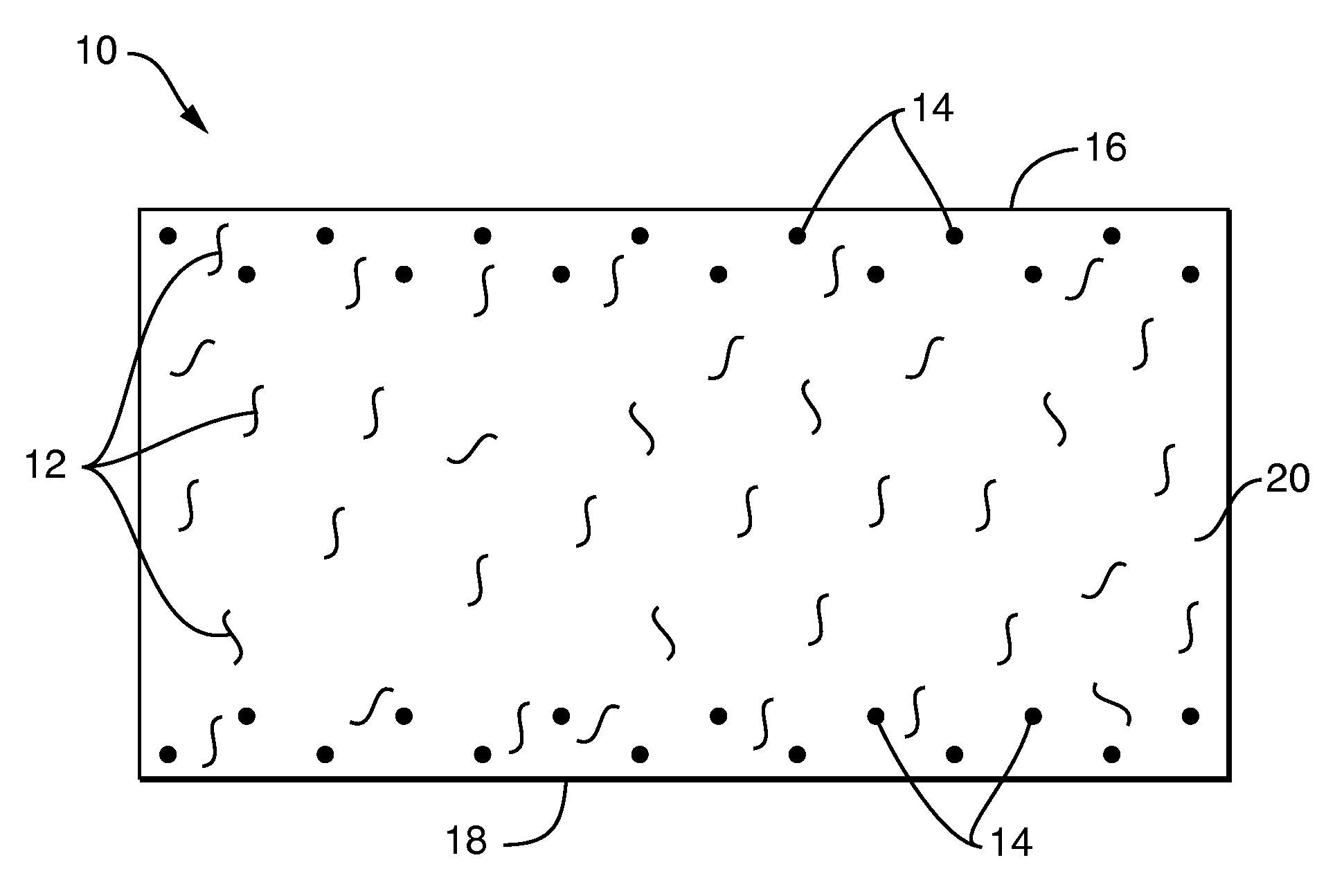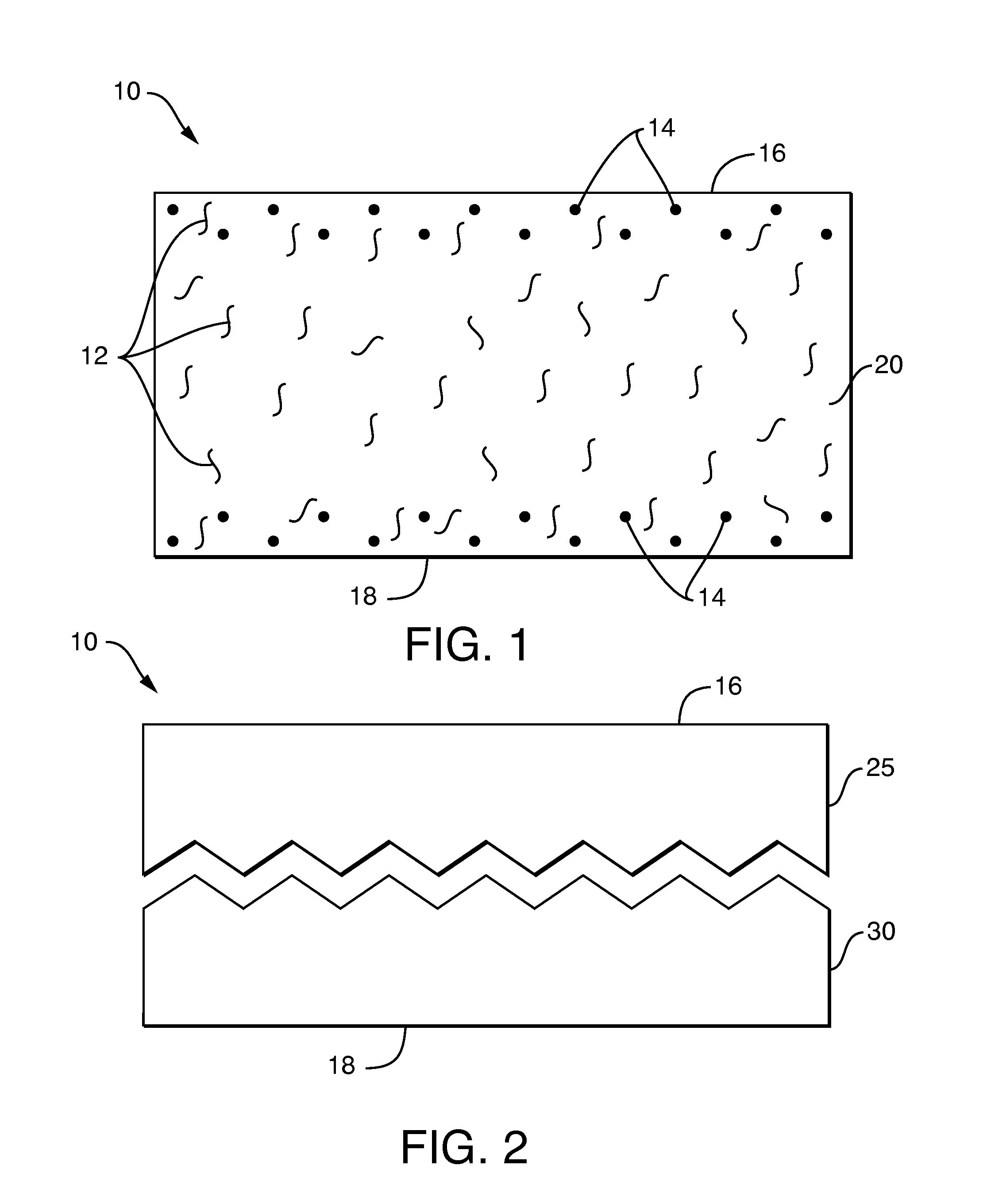Single-Ply Dispersible Wet Wipes with Enhanced Dispersibility
a technology of wet wipes and single-ply fibers, applied in the direction of synthetic resin layered products, transportation and packaging, non-fibrous pulp addition, etc., can solve the problems of quick breakdown in sewer or septic systems, product dispersibility failure, and affecting the disposability of disposable items, etc., to achieve the effect of enhancing the dispersibility of products
- Summary
- Abstract
- Description
- Claims
- Application Information
AI Technical Summary
Benefits of technology
Problems solved by technology
Method used
Image
Examples
example 1
[0155]The basesheet is made using an uncreped through-air-dried tissuemaking process in which a headbox deposits an aqueous suspension of papermaking fibers between forming wires. The newly-formed web is transferred from the forming wire to a slower moving transfer fabric with the aid of a vacuum box. The web is then transferred to a throughdrying fabric and passed over throughdryers to dry the web. After drying, the web is transferred from the throughdrying fabric to a reel fabric and thereafter briefly sandwiched between fabrics. The dried web remains with fabric until it is wound up into a parent roll.
[0156]To form the tissue, a headbox was employed, through which the 100 percent softwood fibers and broke are pumped in a single layer. The fiber was diluted to between 0.19 and 0.29 percent consistency in the headbox to ensure uniform formation. The resulting single-layered sheet structure was formed on a twin-wire, suction form roll. The speed of the forming fabric was 3304 feet p...
example 2
[0160]Examples A and B were tested to show the change in strength of the single-ply wipe from in-use to after-use when the wipe has split into two sections. To determine the after-use strength, samples of the wipes were agitated in tap water using the Slosh Box Test described above for a time period of ten minutes. After ten minutes, the samples have split into two sections through the central portion of the wipe. The After-Use Tensile strength was then measured. Illustrative results are set forth below in Table 2.
TABLE 2In-UseAfter-UseAfter-UseTensileTensileTensileStrengthStrengthStrengthIn-Use Tensile(CD)(MD)(CD)Strength (MD)(g / linear(g / linear(g / linearExampleTissue(g / linear inch)inch)inch)inch)AUCTAD568272133.771.9BUCTAD513264126.274.1
[0161]As can be seen in Table 2, there is a significant loss in strength by splitting into two sections after only ten minutes in the Slosh Box. The loss of strength during the ply separation helps the product easily break up in waste water treatment...
example 3
[0163]For comparative purposes, a basesheet of airlaid nonwoven web was formed continuously on a commercial scale airlaid machine similar to the pilot-scale machine. Weyerhaeuser CF405 bleached softwood kraft fiber in pulp sheet form was used as the fibrous material. This airlaid fibrous material was densified to the desired level by heated compaction rolls and transferred to an oven wire, where it was sprayed on the top side with the a binder composition of a cationic polyacrylate that is the polymerization product of 96 mol % methyl acrylate and 4 mol % [2-(acryloyloxy)ethyl]trimethyl ammonium chloride and Airflex® EZ123 in a 70:30 ratio was used to bond the substrate binder composition, applying approximately half of the desired binder solids onto the dry fibrous material to prepare Comparative Example C. The airlaid basesheet is commonly used with KLEENEX® COTTONELLE FRESH® Flushable Moist Wipes.
[0164]Examples A and B and Comparative Example C were tested to show the air permeab...
PUM
| Property | Measurement | Unit |
|---|---|---|
| Fraction | aaaaa | aaaaa |
| Fraction | aaaaa | aaaaa |
| Fraction | aaaaa | aaaaa |
Abstract
Description
Claims
Application Information
 Login to View More
Login to View More - R&D
- Intellectual Property
- Life Sciences
- Materials
- Tech Scout
- Unparalleled Data Quality
- Higher Quality Content
- 60% Fewer Hallucinations
Browse by: Latest US Patents, China's latest patents, Technical Efficacy Thesaurus, Application Domain, Technology Topic, Popular Technical Reports.
© 2025 PatSnap. All rights reserved.Legal|Privacy policy|Modern Slavery Act Transparency Statement|Sitemap|About US| Contact US: help@patsnap.com


